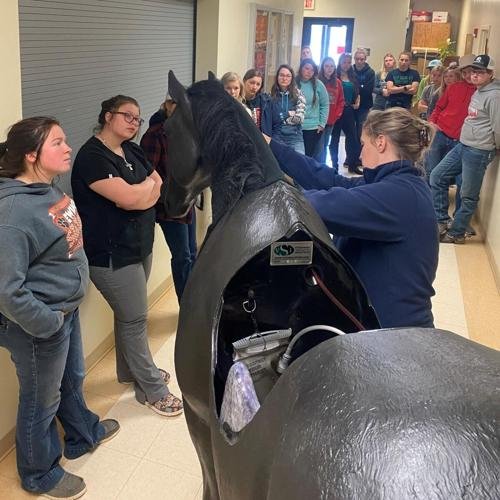No horsing around for students at NCTA with new equine simulator.
When purchasing a horse, one may consider certain physical traits such as breed, how many hands tall or soundness of hooves. Most people would not think twice about the GI tract or reproductive system, but those were the selling points of the equine simulator for the Nebraska College of Technical Agriculture at Curtis, Nebraska.
NCTA was one of 11 education providers in Nebraska to receive a grant for workforce development from the Nebraska Department of Education Perkins reVISION program in 2020. NCTA used the $100,000 grant for four separate programs.
Part of the grant was appropriated to purchase a full-body, life-sized equine palpation and colic simulator. Standing at 15 hands tall, the model mare is equipped with organs for the reproductive, gastrointestinal and circulatory systems.
The equine simulator has been used for a variety of purposes since her arrival to campus in the summer of 2021. Although the simulator provides a safer environment for training of all students, those unfamiliar with large animals especially benefit from the experience gained on a stationary animal.
“The equine simulator’s main purpose is helping students focus and gain technical skill and provide hands-on learning experiences,” said Joanna Hergenreder, associate professor at NCTA.
Complete with “all the bells and whistles,” the model mare allows students to touch and see the incredible size of a horse’s organs. In the past, only after the death of a horse and if the owner conceded could a necropsy be performed. Because the model features the entire body of a horse from head to tail, the simulator can be used beyond its main purposes of reproductive and colic training.
“Since she has a head, I have used her in equitation classes to properly place a bridle,” said Hergenreder. “I also have students practice a belly tap — taking fluid from the abdomen — a procedure that’s really intimidating on a live animal.”
Safety is of utmost importance at NCTA, which is why Hergenreder and her colleagues prefer students to first experiment on the equine simulator before applying the same technique on a real horse.
The outer cavity of the equine simulator is constructed from fiberglass, with a removable tail and mane. All organs are completely removable and replaceable.
Features unique to this model include latex vein tubing that can be replaced after multiple punctures from intramuscular injections or drawing blood. Veins are gravity-fed with fake blood in the tubes to authenticate the venipuncture experience. She even has a pulse.
Catheters can be inserted in her full colic system; most of the GI tract is latex.
The full female reproductive system includes three ovary sizes. The magnetic ovaries are interchangeable to replicate hormone cycles: anestrus, estrus and estrus with follicles.
Students can also practice artificial insemination in a safe environment for both student and patient. Hergenreder explained that students can repeatedly insert the AI pipette into the model without causing damage to the reproductive tract that could be caused to a real mare.
The veterinarian technician and animal science programs utilize the equine simulator, which was purchased from Veterinary Simulator Industries. A Canadian company, VSI designs and manufactures simulators explicitly for animal husbandry. Hergenreder said they chose VSI because a full-body equine simulator was not available at other companies.
Already, the model mare has proven to be a beneficial addition to NCTA.
“Many of our students have little or no experience around live horses, so giving them a chance to perform a variety of procedures on a simulation model allows them to practice until they are comfortable with the procedure before exposing them to the live animal,” said Dr. Larry Gossen, dean of NCTA. “The confidence gained by these students is immeasurable. It in no way however replaces the real thing. It simply adds another level of experience for hands-on learning.

